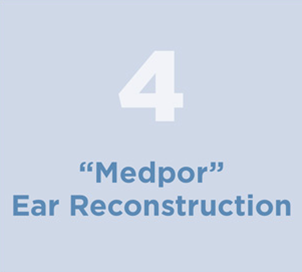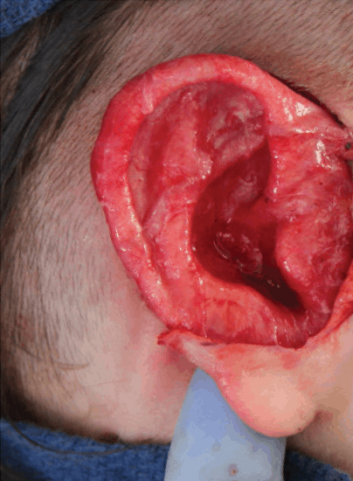-
 Until the day their child was
Until the day their child was
born with MICROTIA, most parents had no idea this condition even existed.

Until the day their child was born with MICROTIA, most parents had no idea this condition even existed.
An internet search on the baby’s first day of life usually reveals the name of the condition and that there are 4 treatment options:






“Medpor” Ear Reconstruction is referred to as Porous Implant Ear Reconstruction (or “PIER”) on this website.
Medpor is a brand of porous polyethylene implant, but since Dr. Lewin now uses a different brand of implant, called Su-Por, the more general term PIER is preferred.
What is Rib Cartilage Ear Reconstruction?
Rib Cartilage Ear Reconstruction was first described in 6 surgical stages by Dr. Radford Tanzer in 1958. Modern microtia surgeons have reduced the number of surgeries required to 2-4 stages depending on the surgeon.


Three rib cartilages are removed from the ribcage.
The rib cage must be large enough to have sufficient cartilage to create an adult-sized ear. Most of the world’s renowned rib cartilage surgeons believe children must be at least 10 years old to perform this technique.


The rib cartilages are carved into small pieces that are stacked and sewn together to create an ear framework.
Rib cartilage ear framework
Photos graciously provided by Dr. Fernanda Valotta


Rib cartilage ear framework
Photos graciously provided by
Dr. Fernanda Valotta
The rib cartilages are carved into small pieces that are stacked and sewn together to create an ear framework.

At the end of Stage 1 surgery

Healed after 1st surgery

The rib cartilage “ear” is then placed inside a skin “pocket” and a suction drain holds the skin onto the ear frame-work. When fully healed, the ear lies flat to the head. In a second surgery, the ear is brought out from the scalp by placing a wedge of rib cartilage (or some surgeons use a polyethylene implant) behind the ear that must be covered with a tissue flap and skin grafts. 2 to 4 surgeries are needed to complete all stages of the ear reconstruction depending on the individual surgeon’s technique.
Photos graciously provided by Dr. Fernanda Valotta

At the end of Stage 1 surgery

Healed after 1st surgery
Photos graciously provided by
Dr. Fernanda Valotta

The rib cartilage “ear” is then placed inside a skin “pocket” and a suction drain holds the skin onto the ear framework. When fully healed, the ear lies flat to the head. In a second surgery, the ear is brought out from the scalp by placing a wedge of rib cartilage (or some surgeons use a polyethylene implant) behind the ear that must be covered with a tissue flap and skin grafts. 2 to 4 surgeries are needed to complete all stages of the ear reconstruction depending on the individual surgeon’s technique
What is Porous Implant Ear Reconstruction (PIER)?
A German surgeon, Dr. Alexander Berghaus, did the world’s first porous implant ear reconstruction in 1982. This technique came to the United States in 1991, and by 1996, a 2-piece Medpor implant made of high density porous polyethylene was used as the structural framework for the ear. Over 20 years later, only minor modifications have been made to the original 2-piece Medpor design. In 2015, Su-Por came out with a similar 2-piece porous implant option. In 2018, Dr. Lewin invented the custom 1-piece 3D Ear by Su-Por.

The helical rim is melted to the ear base to create the ear framework. Extra porous polyethylene is soldered between the two pieces to increase the strength of the implant.

Dr. Lewin used the 2-piece Medpor implant for the first 13 years of her career. However, frustrated with the limitations of the 2-piece implant, Dr. Lewin completely redesigned the porous ear implant to reflect actual ear anatomy.
She now prefers to use customized 1-piece Lewin Ear Implants because they are stronger and
much more realistic than 2-piece implants.
Dr. Lewin’s PIER technique

Lewin Ear Implant

The "Lewin Ear Implant" is a 1-piece implant based on “ideal” ear anatomy, best used for bilateral microtia patients. The “3D Lewin Ear Implant” is based on the actual patient’s natural ear. Both are FDA approved 3-dimensional ear implants designed by Dr. Lewin and manufactured by Su-Por from a single piece of porous polyethylene


The implant is completely covered with nearby tissue from under the scalp called the temporoparietal fascia (“TPF flap”). This thin vascular flap has arteries, veins and nerves coursing through it that grow into the implant and give sensation to the skin grafts that cover the ear.

Healed ear after 1 surgery

When fully healed, a complete ear is made in one operation. The 1-piece PIER technique (developed by Dr. Lewin) creates the appearance of an ear canal due to the 3 dimensionality of the implant and the new way the tragus is constructed. Some patients may require a second surgery.





